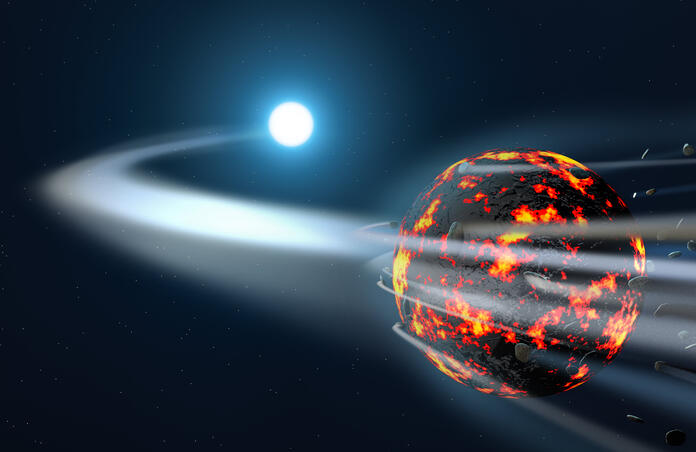Study of polluted white dwarfs reveal stars and planets form at the same time

A team of astronomers have discovered that planet formation in our early solar system started much earlier than previously thought, revealing that developing planets grow at the same time as their host star.
There are still many things to uncover about our solar system's youth, however, astronomers can use other stars to look into the past of planet formation. It is thought that planets can form only once a star has reached its final size, however, research tells another story. For example, a study of some of the oldest stars in the universe showed that planets similar to Jupiter and Saturn began forming whilst their young parent star was growing. This study, along with new data analysed by a team of researchers from 5 universities has altered our understanding of how planetary systems like our own formed and could solve an important puzzle that astronomers have been stuck on. The first author of the study, Dr. Amy Bonsor from Cambridge's Institute of Astronomy, highlights this ongoing issue: “We have a pretty good idea of how planets form, but one outstanding question we've had is when they form: does planet formation start early when the parent star is still growing, or millions of years later?”
To answer this question, the team turned to white dwarfs- the remnants of dead stars which were similar in size to our sun. However, it was a specific group of these ghost stars which they were interested in, called polluted white dwarfs. When small astronomical bodies such as asteroids crash into white dwarfs, they burn up in their atmospheres and ‘pollute’ them, resulting in the atmosphere hosting heavier elements like magnesium, iron and calcium. Although we cannot normally see the interiors of planets using telescopes, spectroscopic observations of this special class of core remnants can probe the interiors of the asteroids which crashed into them, thus providing an insight into the conditions in which they formed.
The leading theory for planet formation currently is that initially, there is a protoplanetary disk comprised of hydrogen, helium and tiny dust and ice particles orbiting a young star. The dust particles interact with each other and stick together, consequently building up to form larger and larger bodies until they accrete enough to reach a sizable planet. Additionally, smaller bodies that don’t grow any further become asteroids.
The group of researchers analysed the atmospheres of 200 polluted white dwarfs found in nearby galaxies and saw that many were rich in iron. This suggests iron-rich asteroids, and for an asteroid to have an iron core, very high temperatures are needed for differentiation to occur. The most likely heat source for this is the decay of radioactive aluminum-26, however, this isotope can only exist for just under 1 million years before decaying away which is extremely short considering the timescale of the universe. Therefore, for the asteroids to undergo radioactive melting and contain the proportion of iron observed, they have to have formed early on at the same time as the star itself.
“The cause of the melting can only be attributed to very short-lived radioactive elements, which existed in the earliest stages of the planetary system but decay away in just a million years," said Bonsor. "In other words, if these asteroids were melted by something which only exists for a very brief time at the dawn of the planetary system, then the process of planet formation must kick off very quickly.”
This research implies that early formation of planets is likely to be the case, and therefore Jupiter and Saturn had a lot of time to grow to their current sizes. Additionally, the analysis shows that this melting process via radioactive decay could be a common mechanism that affects the formation of all exoplanets.
--
Cover image: Amanda Smith
Journal source:
Bonsor, A., Lichtenberg, T., Dra̧żkowska, J. et al. Rapid formation of exoplanetesimals revealed by white dwarfs. Nature Astronomy (2022). https://doi.org/10.1038/s41550-022-01815-8
